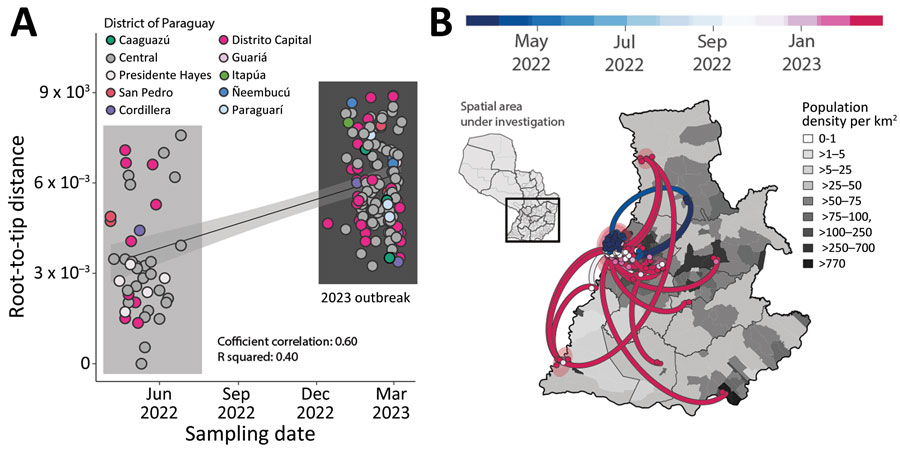Rapid Epidemic Expansion of Chikungunya Virus East/Central/South African Lineage, Paraguay
Marta Giovanetti
1
, Cynthia Vazquez
1, Mauricio Lima
1, Emerson Castro
1, Analia Rojas, Andrea Gomez de la Fuente, Carolina Aquino, Cesar Cantero, Fatima Fleitas, Juan Torales, Julio Barrios, Maria J. Ortega, Maria L. Gamarra, Shirley Villalba, Tania Alfonzo, Joilson Xavier, Talita Adelino, Hegger Fritsch, Felipe C.M. Iani, Glauco C. Pereira, Carla de Oliveira, Gabriel Schuab, Evandra S. Rodrigues, Simone Kashima, Juliana Leite, Lionel Gresh, Leticia Franco, Houriiyah Tegally, Wesley C. Van Voorhis, Richard Lessels, Ana Maria Bispo de Filippis, Andrea Ojeda, Guillermo Sequera, Romeo Montoya, Edward C. Holmes, Tulio de Oliveira, Jairo M. Rico, José Lourenço, Vagner Fonseca, and Luiz C.J. Alcantara
Author affiliations: Università Campus Bio-Medico di Roma, Italy (M. Giovanetti); Instituto Oswaldo Cruz, Belo Horizonte, Brazil (M. Giovanetti, M. Lima, E. Castro, J. Xavier, H. Fritsch, L.C.J. Alcantara); Laboratorio Central de Salud Pública, Asunción, Paraguay (C. Vazquez, A. Rojas, A. Gomez de la Fuente, C. Aquino, C. Cantero, F. Fleitas, J. Torales, J. Barrios, M.J. Ortega, M.L. Gamarra, S. Villalba, T. Alfonzo); Central de Saúde Pública do Estado de Minas Gerais, Ezequiel Dias, Brazil (M. Lima, E. Castro, T. Adelino, F.C.M. Iani, G.C. Pereira); Universidade Federal de Minas Gerais, Belo Horizonte (J. Xavier, H. Fritsch); Instituto Oswaldo Cruz, Rio de Janeiro, Brazil (C. de Oliveira, G. Schuab, A.M.B. de Filippis); University of São Paulo, São Paulo, Brazil (E.S. Rodrigues, S. Kashima); Pan American Health Organization/World Health Organization, Washington, DC, USA (J. Leite, L. Gresh, L. Franco, J.M. Rico); Stellenbosch University, Stellenbosch, South Africa (H. Tegally, T. de Oliveira); University of KwaZulu-Natal, Durban, South Africa (H. Tegally, R. Lessels, T. de Oliveira); National Institutes of Health, Bethesda, Maryland, USA (W.C. Van Voorhis); Dirección General de Vigilancia de la Salud, Asunción (A. Ojeda, G. Sequera); Organización Panamericana de la Salud/Organización Mundial de la Salud Asuncion (R. Montoya); University of Sydney, Sydney, New South Wales, Australia (E.C. Holmes); University of Lisbon, Lisbon, Portugal (J. Lourenço); Organização Pan-Americana da Saúde/Organização/Mundial da Saúde, Brasilia, Brazil. (V. Fonseca)
Main Article
Figure 2

Figure 2. Expansion of the chikungunya East/Central/South/African lineage epidemic in Paraguay. A) Regression of root-to-tip genetic distances and sampling dates estimated by using TempEst version 1.5.3, (http://tree.bio.ed.ac.uk/software/tempest), buffers (shaded area) representing 90% CIs. Colors indicate geographic location of sampling. B) Spatiotemporal reconstruction of the spread of CHIKV ECSA in Paraguay. Circles represent nodes of the maximum clade credibility phylogeny, colored according to their inferred time of occurrence (scale shown). Shaded areas represent 80% highest posterior density interval and depict uncertainty of the phylogeographic estimates for each node. Solid curved lines indicate links between nodes and directionality of movement. Differences in population density are shown on a gray-white scale.
Main Article
Page created: July 14, 2023
Page updated: August 20, 2023
Page reviewed: August 20, 2023
The conclusions, findings, and opinions expressed by authors contributing to this journal do not necessarily reflect the official position of the U.S. Department of Health and Human Services, the Public Health Service, the Centers for Disease Control and Prevention, or the authors' affiliated institutions. Use of trade names is for identification only and does not imply endorsement by any of the groups named above.
